New AMD Ryzen 3000XT Processors Available Today
by Dr. Ian Cutress on July 7, 2020 9:01 AM EST
Announced a couple of weeks ago, the new AMD Ryzen 3000XT models with increased clock frequencies should be available today in primary markets. These new processors offer slightly higher performance than their similarly named 3000X counterparts for the same price, with AMD claiming to be taking advantage of a minor update in process node technology in order to achieve slightly better clock frequencies.
The new 3000XT family of processors focuses mostly on boosting the turbo frequency by 100-200 MHz for the same power. AMD states that this is due to using an optimized 7nm manufacturing process. This is likely due to a minor BKM or PDK update that allows TSMC/AMD to tune the process for a better voltage/frequency curve and bin a single CPU slightly higher.
An update in this range could be indicative of a ~10 mV better voltage for a single core, although this would normally be in the binning noise - for it to be statistically relevant would need a lot of CPUs, so this could just be better binning. However, base frequencies haven’t moved much, so performance-per-watt benefits are going to be somewhat minimal. The biggest uptick would be in 1T scenarios.
Each of the new XT processors is the highest speed variant of its respective class.
| AMD 'Matisse' Ryzen 3000 Series CPUs | |||||||||
| AnandTech | Cores Threads |
Base Freq |
Boost Freq |
L3 Cache |
PCIe 4.0 |
TDP | Price (SEP) |
||
| Ryzen 9 | 3950X | 16C | 32T | 3.5 | 4.7 | 4x16 MB | 16+4+4 | 105W | $749 |
| Ryzen 9 | 3900XT | 12C | 24T | 3.8 | 4.7 | 4x16 MB | 16+4+4 | 105W | $499 |
| Ryzen 9 | 3900X | 12C | 24T | 3.8 | 4.6 | 4x16 MB | 16+4+4 | 105W | $499 |
| Ryzen 9 | 3900 | 12C | 24T | 3.1 | 4.3 | 4x16 MB | 16+4+4 | 65W | OEM |
| Ryzen 7 | 3800XT | 8C | 16T | 3.9 | 4.7 | 2x16 MB | 16+4+4 | 105W | $399 |
| Ryzen 7 | 3800X | 8C | 16T | 3.9 | 4.5 | 2x16 MB | 16+4+4 | 105W | $399 |
| Ryzen 7 | 3700X | 8C | 16T | 3.6 | 4.4 | 2x16 MB | 16+4+4 | 65W | $329 |
| Ryzen 5 | 3600XT | 6C | 12T | 3.8 | 4.5 | 2x16 MB | 16+4+4 | 95W | $249 |
| Ryzen 5 | 3600X | 6C | 12T | 3.8 | 4.4 | 2x16 MB | 16+4+4 | 95W | $249 |
| Ryzen 5 | 3600 | 6C | 12T | 3.6 | 4.2 | 2x16 MB | 16+4+4 | 65W | $199 |
| Ryzen 5 | 3500X | 6C | 6T | 3.6 | 4.1 | 2x16 MB | 16+4+4 | 65W | OEM |
| Ryzen 3 | 3300X | 4C | 8T | 3.8 | 4.3 | 1x16 MB | 16+4+4 | 65W | $120 |
| Ryzen 3 | 3100 | 4C | 8T | 3.6 | 3.9 | 2x8 MB | 16+4+4 | 65W | $99 |
Users should note that the prices listed are official SEP (Suggested Etailer Price). In March, AMD did announce a temporary AMD-focused price drop, but that has since passed. Retailer pricing will vary with local sales practices.
The top new processor is the Ryzen 9 3900XT which offers +100 MHz turbo over the 3900X, for the same official price as the 3900X. The 3800XT offers +200 MHz on single core turbo over the 3800X for the same price. The final new processor is the 3600XT, with +100 MHz on the turbo frequency, again for the same price over the 3600X.
In each three cases, the XT processors give slightly better frequency than the X units, so we should expect to see an official permanent price drop on the X processors in order to keep everything in line.
AMD’s announcement today also includes information about thermal solutions. The Ryzen 5 3600XT, with six cores, will come bundled with AMD’s Wraith Spire cooler. For the other two CPUs, AMD’s own press release states that the company ‘is recommending the use of an AIO solution with a minimum 280mm radiator or equivalent air cooling to experience these products at their best’. This does seem somewhat overkill for 105 W processors, especially if the package power tracking on these parts should be ~142 watts, notwithstanding any trickery that the motherboard manufacturers are doing.
These new processors will be supported in any motherboard that already supports Zen 2-based Ryzen 3000 hardware (the cost in BIOS space to add a CPU of the same family is negligible).
Performance
While we have had these three processors in for testing over the last week or so, we are in the process of transitioning to a new benchmark suite for 2020/2021, with updated CPU tests, newer games, and game testing with RTX 2080 Ti graphics cards. This bench suite is still a work in progress with regression testing older models, and so at this point we do not have a strong enough dataset to confidently do the processors a full review in the AnandTech way. A number of the tests use updated software packages, and so comparison to previous versions is not possible, however we do have some metrics which align that we can share with you.
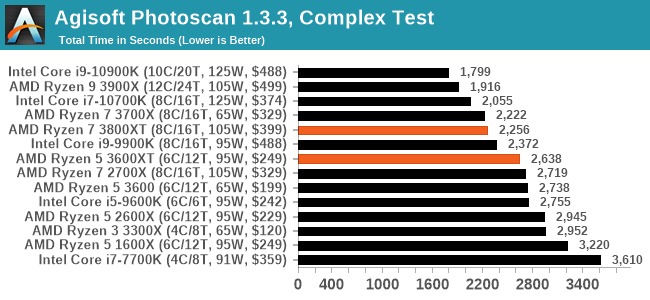
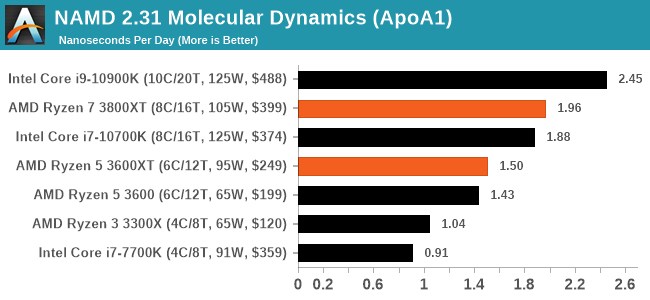

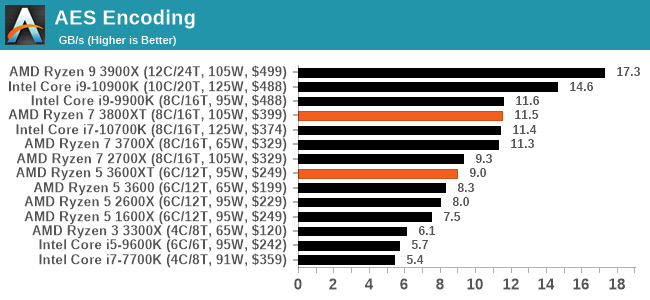
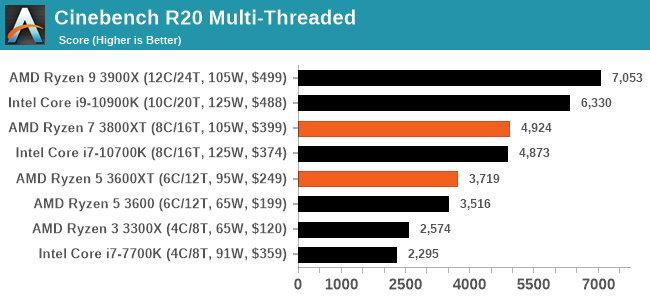
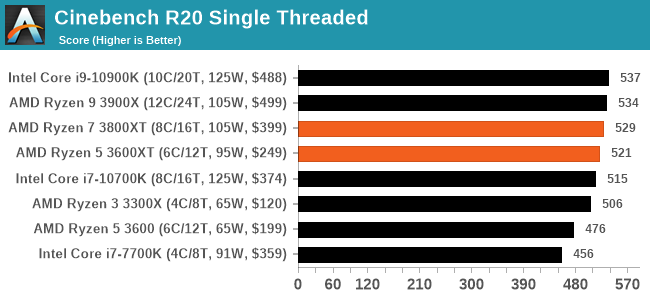
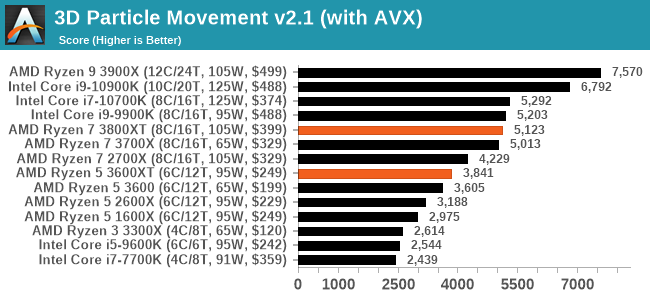
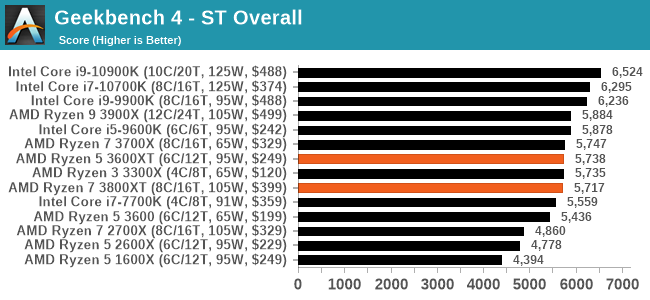
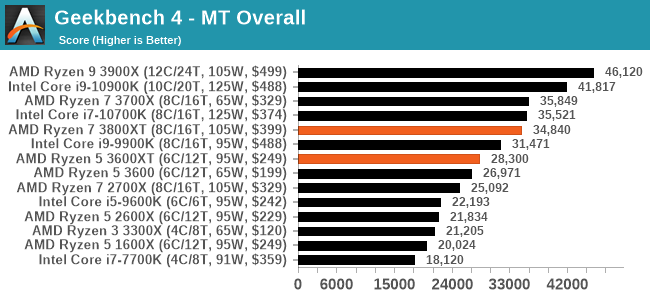
Graphs will be updated as results come in.
As we can see, there isn’t much between the old X models and the new XT models – increasing the turbo frequency a little means that there is scope for increased performance in low thread-count workloads, but ultimately the voltage/frequency curve when we start pushing with more cores loaded counts in those high density benchmarks.
We’re planning on doing a full article with our updated benchmark suite and new tests after we’ve done more regression testing. There will also be a new section in Bench to cover our new benchmark suite. Stay tuned for that.
Related Reading
- AMD To Launch New Ryzen 3000 XT CPUs: Zen 2 with More MHz
- Electromigration: Why AMD Ryzen Current Boosting Won't Kill Your CPU
- AMD Ryzen 5 3600 Review: Why Is This Amazon's Best Selling CPU?
- The AMD Ryzen 3 3300X and 3100 CPU Review: A Budget Gaming Bonanza
- AMD’s Mobile Revival: Redefining the Notebook Business with the Ryzen 9 4900HS (A Review)
- The Corsair Hydro X Custom Water Cooling Review, on a Ryzen 9 3950X
- The ASRock X570 Aqua: A $1000 Ryzen Halo Motherboard Reviewed
- The AMD Ryzen Threadripper 3960X and 3970X Review: 24 and 32 Cores on 7nm










111 Comments
View All Comments
Spunjji - Wednesday, July 8, 2020 - link
We're not the ones with the power to change it. Even all of the people protesting dramatically changing our own lifestyles does nothing more than collapse the economy, because the people participating in it are not the ones with the power to effect the necessary changes.Of course, some of us *have made the changes anyway*.
Deicidium369 - Tuesday, July 7, 2020 - link
Your people are doomed. I think we modified the wrong species.PeachNCream - Wednesday, July 8, 2020 - link
I see you have your fishing rod out. It doesn't look like you put the right bait on the hook.Spunjji - Wednesday, July 8, 2020 - link
Whose people? What species?I can't tell if this is a joke or really, really gross.
brucethemoose - Tuesday, July 7, 2020 - link
As others mentioned, the manufacturing cost is going to blow any kind of TDP saving out of the water.One of the most evironmentally friendly thighs you can do is keep old tech/machinery chugging as long as you can, so you don't have to buy new widgets. Hence the whole right to repair movement.
Lucky Stripes 99 - Tuesday, July 7, 2020 - link
Lowering the thermals is also nice for those of us who live in areas that require air conditioning in the summer. My office gets very toasty if I am not careful about what parts go into my PC, which is why I tend to stick with ≤65W APUs and ≤350W power supplies. My next build is going to be a mini-ITX box that will hopefully be under 120W total.qwertymac93 - Tuesday, July 7, 2020 - link
Attempting to limit energy(resource) USE sociologically generally leads to stunted economic growth and increased mortality. In contrast, enhancing energy(resource) PRODUCTION generally leads to increased economic growth and extended life spans.In short, don't use less; make more.
Just a philosophical bone throw. I see too many people thinking about resources as things that can only be destroyed, when that isn't the case.
PeachNCream - Wednesday, July 8, 2020 - link
More production requires more input. Inputs are finite. Making more things in the name of economic growth seems misguided at best. What might be smarter is finding a way to gracefully decline toward a sustainable steady state. While that might mean economic decline for a while and long-term stagnation our species will at least survive well enough to be able to debate the merits of whether or not more is better with one another. I like that option better than I like the idea of generations of people that come after us struggling to exist in the wasteland of our prior excesses with no means of debate at their disposal besides tossing rocks at one another while they starve to death.Spunjji - Wednesday, July 8, 2020 - link
You realise the outputs of these systems feed back into the inputs, right?Eventually you hit a point where your paradigm no longer holds true. It's an observation of a system operating within certain parameters, not a universal law.
haukionkannel - Wednesday, July 8, 2020 - link
Increasing tdp does not help 7nm product much... one reason why Intel highend still is 14nm... it scales with super high tdp better than 10nm or 7nm...